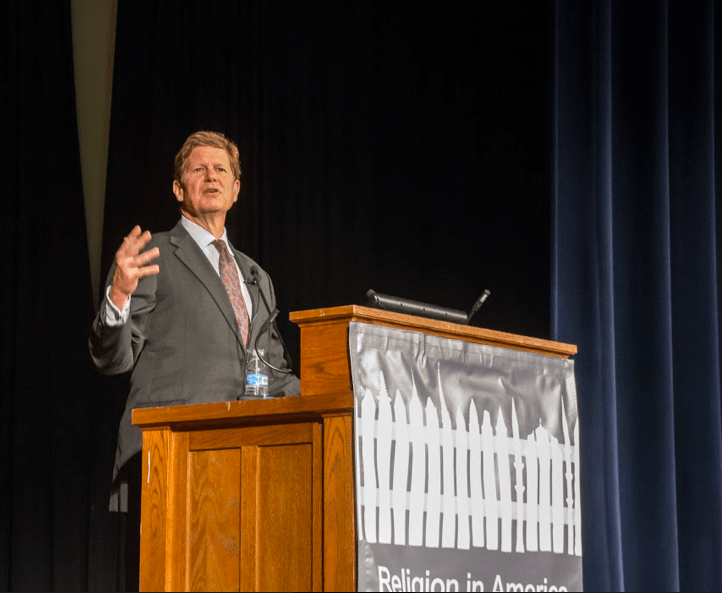Award-winning historian Randall Balmer spoke about the history of evangelicalism. Photo by Autumn Walter.
After a brief two-week break, this year’s Honors Colloquium lecture series on “Religion In America” returned with speaker Randall Balmer, a prize-winning historian, Emmy nominee and current chair of religion at Dartmouth College.
Balmer brought his decades of teaching religious history to the stage at Edwards Auditorium Tuesday night to discuss the vast history of American evangelicalism from the 16th century to the present.
As Balmer defined it, evangelicalism refers to the “good news” of salvation through Jesus Christ. Beginning in the 16th century, the term “evangelical” took on a slightly different meaning with Martin Luther’s discovery of the New Testament and the writings of St. Paul.
According to Balmer, these teachings combatted the traditional Medieval Catholic ideology of works righteousness, stating that one is saved through faith rather than by works. He described this doctrine to be “a kernel of the reformation theology known also as evangelical theology.”
Balmer said the middle decades of the 18th century were when evangelicalism became a major presence in North America in a period known as The Great Awakening. This period was convulsed with religious revivals, especially under the influence of George Whitfield, an Anglican minister known for traveling along the Atlantic seaboard and attracting massive audiences.
Balmer further explained The Great Awakening by emphasizing the “Three P’s,” which came together to form “the genesis of evangelicalism in America.” The first being puritanism, which set the standard for an introspective piety in modern evangelicalism; the second being presbyterianism, which set the modern standard of doctrinal precision; and the third being pietism, which emphasized the importance of warm-hearted and affective piety.
“I think it’s still possible to trace remnants of each of those three P’s in contemporary American evangelicalism,” Balmer said.
After the American Revolution and in the decades surrounding the turn of the 19th century, the Second Great Awakening began taking shape. Balmer explained that this stage of revivalism would take place primarily in three separate regions: New England, principally out of Yale College; the Cumberland Valley of Kentucky, defined by the era of “camp meeting revivals,” most notably in Cain Ridge in 1802; and in upstate New York, by the newly-settled Erie Canal, defined by prosperous economy and influx of populations.
One particular figure to rise out of the New York evangelical settlement was Charles Grandison Finney, whom Balmer described as “by any measure the most important and influential evangelical of the 19th-century.” Finney was a major proponent of the theory of benevolence, which stated that those who were transformed by the grace of God were responsible for making the world a better place.
Balmer explained that this sparked a major push for evangelicals towards issues of social reform, a stark contrast to the nearly polar-opposite ideologies and agendas many contemporary evangelicals hold. Evangelicals became widely concerned about citizens who lived on the margins of society, and those concerns would become reflective of their stances on various issues. This included advocating for prison reform, leading peace crusades, support of public education, abolition, women’s suffrage and gun control. Even the notion of capitalism, according to many evangelicals during the 19th century, was deemed inconsistent with the teachings of God.
Balmer said that moving into the 20th century, evangelicalism is defined by the idea of premillennialism, which is the idea that the second coming of Christ will happen at any moment, taking the faithful to heaven and leaving the rest to face judgment on Earth.
Balmer also began to note the general recession of evangelicalism from larger culture beginning in 1925 with the Scopes Evolution Trial in Dayton, Tennessee. With the prosecution against John Scopes losing in the court of public opinion, evangelicals began to construct a subculture; a vast and interlocking network of congregations, missionary societies, colleges, etc. Balmer states, “this becomes a defensive posture against a larger world that came to be understood as both corrupt and corrupted.”
From then on, decades of building different strains of evangelicalism, as well as an ever-growing community, would culminate in the evangelical resurgence in the 1970s following the election of Jimmy Carter. Evangelicals, seeing Carter so openly talk about his born-again faith and be taken seriously as a contender, would relish the opportunity to vote for one of their own, according to Balmer.
It was during this administration that the “religious right” as we know today began to mobilize, following the controversial Green v. Connally ruling that declared that racially discriminatory private schools would no longer be tax-exempt, catching the attention of religious leaders like Bob Jones and Jerry Falwell.
Balmer explained that this trend of the “religious right” carried over into the 1980s with the election of Ronald Reagan, all the way to 2016 with the election of Donald Trump, in which 81 percent of white evangelicals voted for Trump. With more and more religious voters aligning with the far-right precincts of the Republican Party, Balmer states that the “religious right” is finally beginning to drop the pretense of “family values,” reverting back to the charter principle of racism under which they had formed.
“I think evangelicalism died on Nov. 8, 2016,” he said.





